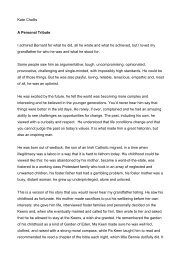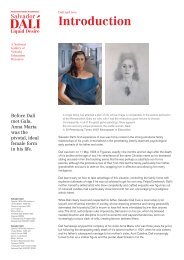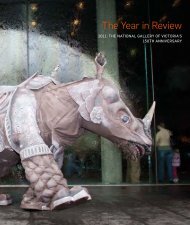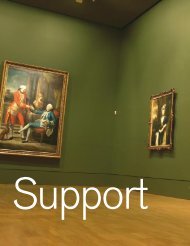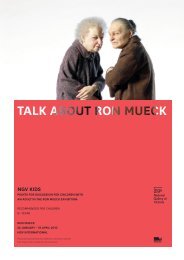Giambattista tiepolo The banquet of Cleopatra 1743–44 - National ...
Giambattista tiepolo The banquet of Cleopatra 1743–44 - National ...
Giambattista tiepolo The banquet of Cleopatra 1743–44 - National ...
You also want an ePaper? Increase the reach of your titles
YUMPU automatically turns print PDFs into web optimized ePapers that Google loves.
<strong>Giambattista</strong> <strong>tiepolo</strong><br />
<strong>The</strong> <strong>banquet</strong> <strong>of</strong> <strong>Cleopatra</strong> <strong>1743–44</strong><br />
un paseo por el arte
<strong>Giambattista</strong> <strong>tiepolo</strong><br />
Italian 1696–1770<br />
<strong>The</strong> <strong>banquet</strong> <strong>of</strong> <strong>Cleopatra</strong> <strong>1743–44</strong><br />
oil on canvas<br />
250.3 x 357.0 cm<br />
<strong>National</strong> Gallery <strong>of</strong> Victoria, Melbourne<br />
Felton Bequest, 1933 (103-4)<br />
<strong>The</strong> story <strong>of</strong> Mark Antony (83–30 BC) and <strong>Cleopatra</strong> (69–30<br />
BC) was a popular subject for artists in the eighteenth century.<br />
<strong>The</strong> ancient tale <strong>of</strong> the Roman consul and his relationship with<br />
the Egyptian queen provided them with stories <strong>of</strong> romance, war,<br />
military splendour, tragedy and death. <strong>The</strong> love affair between<br />
Mark Antony and <strong>Cleopatra</strong> also enabled artists to depict the<br />
classic opposites <strong>of</strong> male and female, East and West.<br />
<strong>The</strong> episode represented in Tiepolo’s <strong>The</strong> <strong>banquet</strong> <strong>of</strong> <strong>Cleopatra</strong><br />
is drawn from the Roman historian Pliny’s Natural History (written in<br />
AD 77). Here Pliny recounted the tale <strong>of</strong> a famous contest between<br />
the Egyptian and Roman rulers (who became lovers), whereby<br />
<strong>Cleopatra</strong> wagered that she could stage a feast more lavish than the<br />
legendary excesses <strong>of</strong> Mark Antony. Tiepolo’s painting shows the<br />
dramatic moment at the end <strong>of</strong> <strong>Cleopatra</strong>’s sumptuous repast when,<br />
faced with a still scornful Mark Antony, she wins the wager with her<br />
trump card. Removing one <strong>of</strong> a pair <strong>of</strong> priceless pearls that adorn her<br />
as earrings, <strong>Cleopatra</strong> dissolves the pearl in a glass <strong>of</strong> vinegar and<br />
drinks it, an extravagance that causes Mark Antony to lose his bet.<br />
<strong>The</strong> <strong>banquet</strong> <strong>of</strong> <strong>Cleopatra</strong> was purchased directly from Tiepolo’s<br />
Venice studio in early 1744 by Count Francesco Algarotti for Augustus<br />
III, Elector <strong>of</strong> Saxony and King <strong>of</strong> Poland. A member <strong>of</strong> the Court <strong>of</strong><br />
Saxony, Algarotti had presented the king in 1742 with a proposal<br />
to update the Royal Museum at Dresden through the acquisition <strong>of</strong><br />
a small selection <strong>of</strong> modern paintings that would balance the old<br />
masters already in the king’s collection. <strong>Giambattista</strong> Tiepolo, at the<br />
time one <strong>of</strong> the most celebrated contemporary artists working in<br />
Europe, was an obvious choice for Algarotti. Surviving documents<br />
tell us that on 10 February 1744 Count Algarotti paid for a frame<br />
for <strong>The</strong> <strong>banquet</strong> <strong>of</strong> <strong>Cleopatra</strong>. On 5 March 1744 the artist was paid<br />
300 zecchini (Venetian gold coin) for the painting, which was then<br />
dispatched to Dresden (and, subsequently, to the Royal Hunting<br />
Lodge at Hubertusburg), remaining in the royal collections <strong>of</strong> Saxony<br />
until 1765. By the turn <strong>of</strong> the nineteenth century, <strong>The</strong> <strong>banquet</strong> <strong>of</strong><br />
<strong>Cleopatra</strong> had entered the Russian imperial collections, and was<br />
for a time placed on a ceiling within the Mikhailovsky Castle in St<br />
Petersburg. Later it was transferred to the Hermitage Palace, where<br />
it remained until sold to Melbourne by the Soviet authorities in 1932.<br />
Ted Gott<br />
<strong>Giambattista</strong> <strong>tiepolo</strong><br />
Italiano 1696–1770<br />
El <strong>banquet</strong>e de <strong>Cleopatra</strong>, (<strong>1743–44</strong>)<br />
óleo sobre lienzo<br />
250,30 x 357,00 cms<br />
Galería Nacional de Victoria, Melbourne<br />
Legado Felton, 1933 (103-4)<br />
La historia de Marco Antonio (83-30 a.C.) y <strong>Cleopatra</strong> (69-30<br />
a.C.) fue un tema popular entre los artistas de siglo XVIII. La<br />
historia de la relación entre el cónsul romano y la reina egipcia<br />
les proporcionó romance, guerra, esplendor militar, tragedia y<br />
muerte. La aventura amorosa entre Marco Antonio y <strong>Cleopatra</strong><br />
permitió a los artistas reflejar en sus obras el clásico contraste<br />
entre lo masculino y lo femenino, oriente y occidente.<br />
El episodio representado en El <strong>banquet</strong>e de <strong>Cleopatra</strong> de Tiepolo<br />
se inspira en La historia natural del historiador romano Plinio (escrita<br />
en el 77 d.C.). Plinio narra la famosa competición entre la reina<br />
egipcia y el cónsul romano (que luego serían amantes). <strong>Cleopatra</strong><br />
había apostado que podía <strong>of</strong>recer un <strong>banquet</strong>e más lujoso que los<br />
legendarios y excesivos de Marco Antonio. El cuadro de Tiepolo<br />
muestra el momento dramático, al final de la suntuosa comida,<br />
en el que <strong>Cleopatra</strong>, frente al todavía desafiante Marco Antonio,<br />
gana la apuesta al quitarse uno de sus valiosísimos pendientes<br />
de perlas, disolver la perla en un vaso de vinagre y bebérselo,<br />
extravagancia que hace que Marco Antonio pierda la apuesta.<br />
A principios de 1744 El <strong>banquet</strong>e de <strong>Cleopatra</strong> fue comprado<br />
directamente al estudio de Tiepolo en Venecia por el conde Franchesco<br />
Algarotti para el rey de Polonia y elector de Sajonia Augusto III.<br />
Algarotti había propuesto al rey en 1742 un plan para modernizar<br />
el Museo Real de Dresde mediante la adquisición de una pequeña<br />
selección de pinturas modernas y así crear un cierto equilibrio con las<br />
antiguas obras maestras de arte ya existentes en la colección real.<br />
Para Algarotti, el adquirir una obra de <strong>Giambattista</strong> Tiepolo, uno de los<br />
artistas contemporáneos más famosos en Europa, era una decisión<br />
obvia. Sabemos, gracias a los documentos que hoy perduran, que el<br />
10 de febrero de 1744 el Conde Algarotti pagó el coste del marco;<br />
y que el 5 de marzo de 1744 le pagaron al artista 300 zecchini .<br />
El cuadro fue enviado a Dresde (y, posteriormente, al palacete de<br />
caza de Hubertusburg) y permaneció en la colección real de Sajonia<br />
hasta 1765. A finales del siglo XIX El <strong>banquet</strong>e de <strong>Cleopatra</strong> pasó<br />
a la colección imperial rusa y durante un tiempo estuvo colgado del<br />
techo del Castillo de Mikhailovsky en San Petesburgo. Más tarde,<br />
fue trasladado al Palacio Hermitage donde permaneció hasta que<br />
fue vendido a Melbourne por las autoridades soviéticas en 1932.
Thinking and discussing before the visit<br />
Tiepolo’s art was executed in oil paints or fresco, a painting technique suitable for walls<br />
and ceilings in which water-based pigments are applied to a surface <strong>of</strong> wet plaster.<br />
You probably already know something about <strong>Cleopatra</strong>, the enigmatic<br />
Ptolemaic queen <strong>of</strong> ancient Egypt who lived from 69–30 BC.<br />
• How do you picture her? As a class, discuss and list all the things you already know about<br />
her. Where did your information come from – teachers, books, the internet, popular culture?<br />
• Discuss whether we can ever be certain that the information<br />
we learn from these sources is true.<br />
• <strong>The</strong>re have been many contradictory portrayals <strong>of</strong> <strong>Cleopatra</strong> over time. Choose some<br />
particular questions about her that you would like to investigate such as: was she a villain<br />
or a hero? Is there evidence to suggest she was beautiful? What aspects <strong>of</strong> her life have<br />
made her so famous? Who were the most important men in her life? Is there evidence<br />
to suggest that she was an intelligent and courageous ruler? How did she die?<br />
• Individually or in small groups, conduct further research about <strong>Cleopatra</strong> and<br />
present your findings to the class in the form <strong>of</strong> an illustrated PowerPoint lecture,<br />
an essay, visual diagram or short performance involving drama and music.<br />
• What factors affect our understanding <strong>of</strong> history?<br />
Gallery visit activities<br />
• Describe what you see when you look at the painting.<br />
• Who or what stands out and why?<br />
• Describe the palette <strong>of</strong> colours the artist has used. How do they<br />
contribute to the extravagance and drama <strong>of</strong> the occasion?<br />
• Consider in what ways the artist has directed our eye to the key action in the<br />
painting (the vanishing point above <strong>Cleopatra</strong>’s glass on the table).<br />
• How could you guess from the visual clues in the painting that this story took<br />
place during the ancient civilizations <strong>of</strong> Egypt, Rome and Greece?<br />
• Study the facial expressions <strong>of</strong> the people depicted in the<br />
painting—what mood or atmosphere do they suggest?<br />
• How has Tiepolo depicted the body language <strong>of</strong> <strong>Cleopatra</strong> and Mark<br />
Antony? What does this suggest about how each <strong>of</strong> them is feeling?<br />
• If you are not yet familiar with the story depicted in the painting, try to work out<br />
what might be happening in the painting based on your observations so far.<br />
• When your teacher or NGV guide has explained the story, discuss what universal<br />
human qualities are explored in the painting that are still relevant today.<br />
• Both <strong>Cleopatra</strong> and the Venetian aristocracy lived decadent, pleasureseeking<br />
lives in societies that were in decline. Can you suggest why Tiepolo<br />
might have depicted the Egyptian queen as a Venetian aristocrat?<br />
• What aspects <strong>of</strong> the painting puzzle you? What questions would<br />
you like to ask Tiepolo if he were alive today?<br />
• Create a newspaper headline that you think encapsulates they key themes <strong>of</strong> the story.<br />
• What factors relating to the display <strong>of</strong> <strong>The</strong> <strong>banquet</strong> <strong>of</strong> <strong>Cleopatra</strong> suggest<br />
that it is a very important painting in the NGV collection?<br />
Research and discuss the life and<br />
paintings <strong>of</strong> Diego Rivera. He<br />
is arguably the greatest Mexican<br />
painter <strong>of</strong> the twentieth century and<br />
is credited with the reintroduction<br />
<strong>of</strong> fresco painting into modern art<br />
and architecture. His large murals<br />
on universities and other public<br />
buildings introduced his work into<br />
the everyday lives <strong>of</strong> the people.<br />
Useful link<br />
http://diegorivera.com/murals/index.php<br />
<strong>The</strong> following individual lines are<br />
taken from a poem <strong>The</strong> Banquet<br />
<strong>of</strong> <strong>Cleopatra</strong> — A Painting by<br />
Giovanni Battista Tiepolo by John<br />
Mateer, inspired by the painting:<br />
Rigid with competitive<br />
arrogance, her arm is silencing<br />
us all with a held moment.<br />
And at her fingertips the famous<br />
pearl gleaming like our star seen<br />
from another solar system.<br />
Create an evocative sentence<br />
that describes one aspect <strong>of</strong><br />
the painting in detail.<br />
un paseo por el arte
Gallery visit activities, continued<br />
• Tiepolo’s paintings show the influence <strong>of</strong> the seventeenth-century Baroque<br />
style, characterised by much ornamentation, dramatic light and shade<br />
and exaggerated emotional expression. Discuss where you can see<br />
evidence <strong>of</strong> these characteristics in <strong>The</strong> <strong>banquet</strong> <strong>of</strong> <strong>Cleopatra</strong>.<br />
Post-visit activities<br />
In 1762 Tiepolo moved to Spain where his commissioned work<br />
included frescos on the ceilings <strong>of</strong> the Royal Palace in Madrid.<br />
• Research the life <strong>of</strong> the ruling monarch at the time, Charles III.<br />
• What pr<strong>of</strong>ound reforms did he carry out? How did he transform Madrid?<br />
• Can you imagine any famous people today behaving in a similar way to <strong>Cleopatra</strong> and<br />
Antony in this painting? If so, who might they be and what would your reaction be?<br />
Create an artwork or short play that depicts a modern day version <strong>of</strong> the story.<br />
Research the life <strong>of</strong> Tiepolo. Find<br />
out about his great rival in Spain,<br />
Anton Raphael Mengs. Why<br />
was Tiepolo’s work unpopular<br />
in Spain at the end <strong>of</strong> his life?<br />
<strong>The</strong> following activity encourages<br />
students to think about a story or<br />
topic from diverse perspectives:<br />
As a class, brainstorm various<br />
viewpoints about the story in the<br />
painting. Consider who is involved,<br />
who might be affected by it and<br />
how it might be viewed by people<br />
<strong>of</strong> diverse ages, pr<strong>of</strong>essions, cultures<br />
and different times in history.<br />
Students take on the role <strong>of</strong><br />
the character with one <strong>of</strong> these<br />
viewpoints and describe the<br />
story from his or her perspective.<br />
Characters could include<br />
a contemporary politician,<br />
psychologist, feminist, playwright,<br />
vet, dietician, gossip columnist,<br />
detective, a poor Egyptian citizen,<br />
or <strong>Cleopatra</strong> or Antony themselves.



